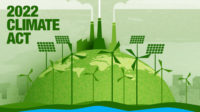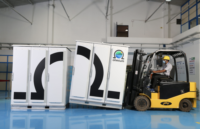The U.S. Treasury Dept. released on Dec. 22 long-awaited proposed rules for U.S. hydrogen project developers to gain maximum federal tax credits in building U.S. facilities that meet standards for lowest-carbon emissions and for prevailing wage and registered apprenticeship. But finalizing the incentive now will involve balancing disputed views related to how projects tap clean fuel sources and how they track and report their carbon emissions.
To obtain the 45V production credit under the 2022 Inflation Reduction Act, clean hydrogen projects must limit emissions to 4 kg of carbon dioxide equivalent for every kilogram of hydrogen to qualify for credits—less than half of the 9 kg of CO2 typically generated today.
The proposal appears in the Dec. 28 Federal Register, with comments due in 60 days, but there is no clear forecast on when it will be final.
One industry expert who declined to be identified voiced concern about "a lack of coordination in the administration" by Treasury, the U.S. Energy Dept. and U.S. Environmental Protection Agency, the key agencies involved in federal hydrogen funding and regulation but that have taken differing views on issues. "There is no internal coordination by agencies ... to go down a consistent path," he said. The expert added that the tax credit finalization process coming in an election year faces the risk of being halted, or a final rule being radically changed or nullified, if there is a Republican administration or change in the Congressional political makeup.
Treasury says facilities aiming to manufacture "green" hydrogen made from non-fossil fuel energy sources that meet requirements could gain a credit of up to $3 per kilogram produced, depending on life-cycle emissions of hydrogen production and use. Developers see the top-end credit as critical to compete with the estimated $1 to $2 per kg cost of producing U.S. dominant "gray" hydrogen from unabated natural gas and "blue" hydrogen from gas with carbon capture technology.
Clean hydrogen will be critical in reducing emissions from harder-to-decarbonize heavy industry and heavy transportation sectors, says the International Energy Agency. The administration aims to expand U.S. clean hydrogen production to 50 million metric tons annually by mid-century, about 50 times its current level.
Catalyst for Green Steel
Hydrogen is seen as a catalyst for green steel manufacturing in Minnesota’s Iron Range, which supplies about 75% of U.S. iron ore, says Tom Erickson, president and chief operating officer of Heartland Hydrogen Hub, a Midwest-based production partnership awarded in October about $925 million from DOE to boost infrastructure development. It is one of seven regional hubs now negotiating a total of $7 billion to increase the supply of commercial green hydrogen as a less carbon intensive power fuel source.
Treasury says hydrogen produced by fossil fuels, including renewable natural gas and gas emitted from oil drilling, would qualify for credits, with carbon capture added. But “safeguards outlined in the proposed rules are critical to preventing the credit from subsidizing hydrogen production with higher life-cycle greenhouse gas emissions than allowed by the statute,” the proposal says.
To claim the credit, a developer must have production and sale or use of clean hydrogen verified "by a qualified, unrelated third party," says Treasury. “The credit is available for 10 years starting on the date that a hydrogen production facility is placed into service for projects that begin construction before 2033, meaning it will remain available for some facilities well into the 2040s.”
Looking at Issues
But remaining to be clarified in final rulemaking is a proposed "additionality" requirement that a hydrogen facility tap renewable or zero-emission power from a source that began operation no more than three years before its construction to insure that the power use would not divert clean energy already on the grid.
"The additionality rule is setting a precedent," said the industry expert, noting that installation of new dedicated wind or solar power generation could "risk stranding the assets" if there are no other users. "There needs to be enough value to maintain capital costs that have to be spent," he said. "The cheapest assets are existing, not new."
The requirement leaves nuclear sector developers questioning how existing plant power used to fuel new hydrogen projects could gain maximum credit to support construction cost.
One voicing concern is plant operator Constellation Corp. It began operating in March what it said is the world's first nuclear-powered hydrogen production facility, a 1-MW pilot at an existing upstate New York power station, and also committed in October to build a $900-million plant at an Illinois nuclear site that would produce 33,450 tons per year—both with DOE funding. "If finalized, America will surrender hydrogen and deep decarbonization leadership to China and Europe, both of which have policies that smartly utilize their existing nuclear plants to make hydrogen and speed decarbonization," Constellation said in a statement.
The White House has indicated that final rules could provide more options based on new information provided. The proposal includes a "carveout" that would allow a share of a nuclear power provider's generation to be used for clean hydrogen, one official told a media briefing.
Treasury also has proposed a phased compliance for developers to gain allowable credits for a green hydrogen project based on reporting of its emissions linked to consumption of clean electricity. The agency proposes that, until 2028, the connection can be reported at any time of the year—known as "annual" matching and favored by industry—rather than on an hourly basis, which green energy proponents claim is a more accurate measure.
In the proposal, Treasury says hourly tracking systems are set to be more widely available by 2028, but it specifically seeks comment on this transition timeline.
The proposed U.S rules are stricter than those adopted by the European Union, which allow matching of renewable power to electrolyzer operation within a calendar month until 2030, after which it must be done within a one-hour window.
Earlier this year, a group of utilities and other companies, which included Black & Veatch and Kiewit Corp., noted in a letter to Treasury that the annual match “can be both clean and cost effective,” also raising key concern that the hourly match “would increase the price of clean hydrogen to effectively negate the economic and decarbonization benefits" of the tax credit.
Taking issue with the hourly matching mandate's proposed phase-in timing, Jason Grumet, president of the American Clean Power Association, said imposing the provision "too early for first-wave green hydrogen projects will discourage a significant majority of clean power companies from investing in green hydrogen manufacturing and facilities."
He termed the proposed timeline "a fundamental obstacle" to commercialized U.S. green hydrogen, claiming that more flexibility "presents little risk of a material increase in emissions." The group, which represents energy storage, wind, utility-scale solar, green hydrogen and transmission companies, urged the Biden Administration to address what it called "a fatal – but fixable – flaw."
But Rachel Fakhry, who leads hydrogen and energy innovation advocacy for the Natural Resources Defense Council, said in a blog post advocating hourly matching, "It is critical that the [federal government] get the system right if hydrogen is to fulfil its potential as a climate solution." She stressed that the U.S. "should set world-leading standards to meet the law's intent, scale up truly 'clean' hydrogen sources and lift global boats," urging the administration to "hold the line" as it finalizes the tax credit rules.
Meanwhile, DOE said in mid January it tapped three firms, including S&P Global, to create a clean hydrogen demand market framework that will boost private investment.






Post a comment to this article
Report Abusive Comment